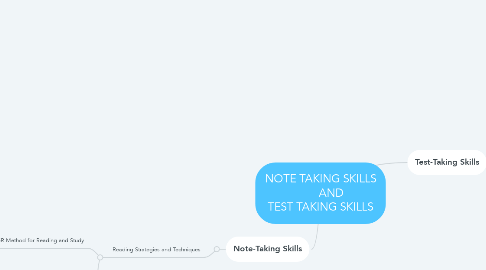
1. Note-Taking Skills
1.1. Reading Strategies and Techniques
1.1.1. The SQ5R Method for Reading and Study
1.1.1.1. Effective Study Environments
1.1.1.1.1. Summary
1.1.1.1.2. Background Music Studying with headphones tends to decrease retention/memory, whereas music in the background can be an aid to study. Study Locations For the room to “work” for a student, the student must know if they have the characteristics to study in their room. First of all, it is essential that the student be very organized and not let themselves be distracted by the more fun things they have around, such as computer games, e-mail, friends and roommates, parties, etc. The student should have all their materials close by, and be able to set a task and get it done. Study Groups Focused Focused, organized study groups can provide the best of all study environments. The group can arrange to meet in a quiet location, set an agenda of material to be covered, and can be a resource for help if a member of the group gets stuck doing a problem. Study Situations to Avoid It is commonly agreed that the following situations do not provide good study environments: Working with headphones on Studying in front of a TV Trying to work with a significant other who is not taking the same classes as you are, or who does not feel like studying Trying to study near any activity you enjoy
1.1.1.2. The SQ5R Reading Method is one technique that may help improve your reading comprehension The SQ5R Method includes 5 steps for thorough reading
1.1.1.2.1. Step 1: Survey Step 2: Questions Step 3: Read Step 4: Recall Step 5: Review
1.1.2. Notetaking often requires several drafts. The rewriting of notes is the beginning of committing your notes to memory; let’s explore some methods for effective notetaking and rewriting.
2. Test-Taking Skills
2.1. Multiple-Choice and Objective Question Strategies
2.1.1. True/False Question Strategies
2.1.1.1. Essay Question Strategies
2.1.1.1.1. Managing Test Anxiety
2.1.1.1.2. Read over all the essay questions before you start to write. Underline keywords like define, compare, explain, etc. Think before you write.
2.1.1.2. True/False questions often use qualifiers as well. When the word always appears, if you can think of a single instance in which the statement is not true, you know the answer is false. For example, All students have poor study habits. Or, Multiple choice tests are never harder than an essay test.
2.1.2. As you read the beginning of a multiple-choice question, try to answer the question first without looking at the possible solutions. If your answer appears on the list, you will feel more confident in your choice. If you are not able to guess the solution, examine the choices and eliminate the ones you know are incorrect through informed guessing. Check for keywords in the question.
